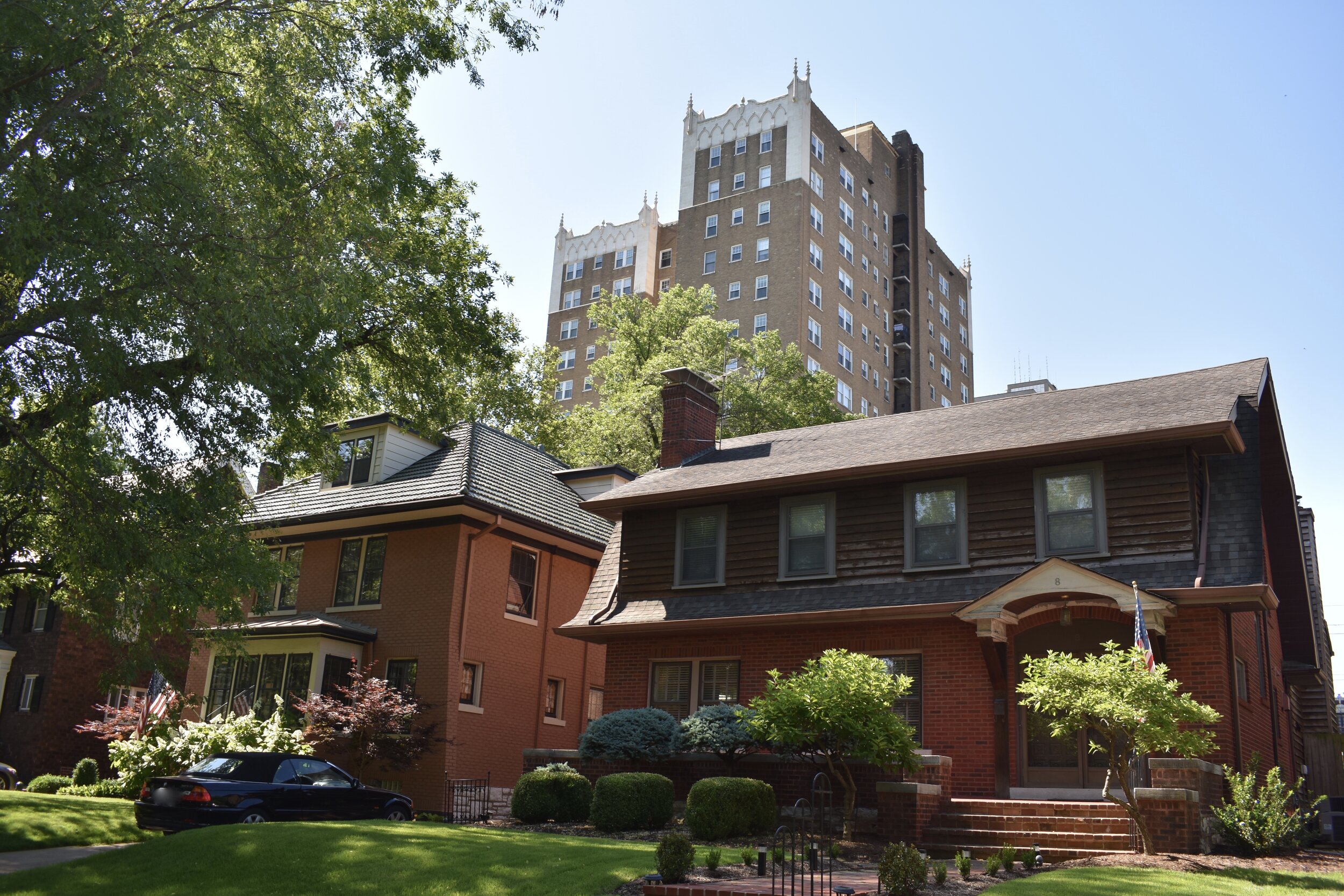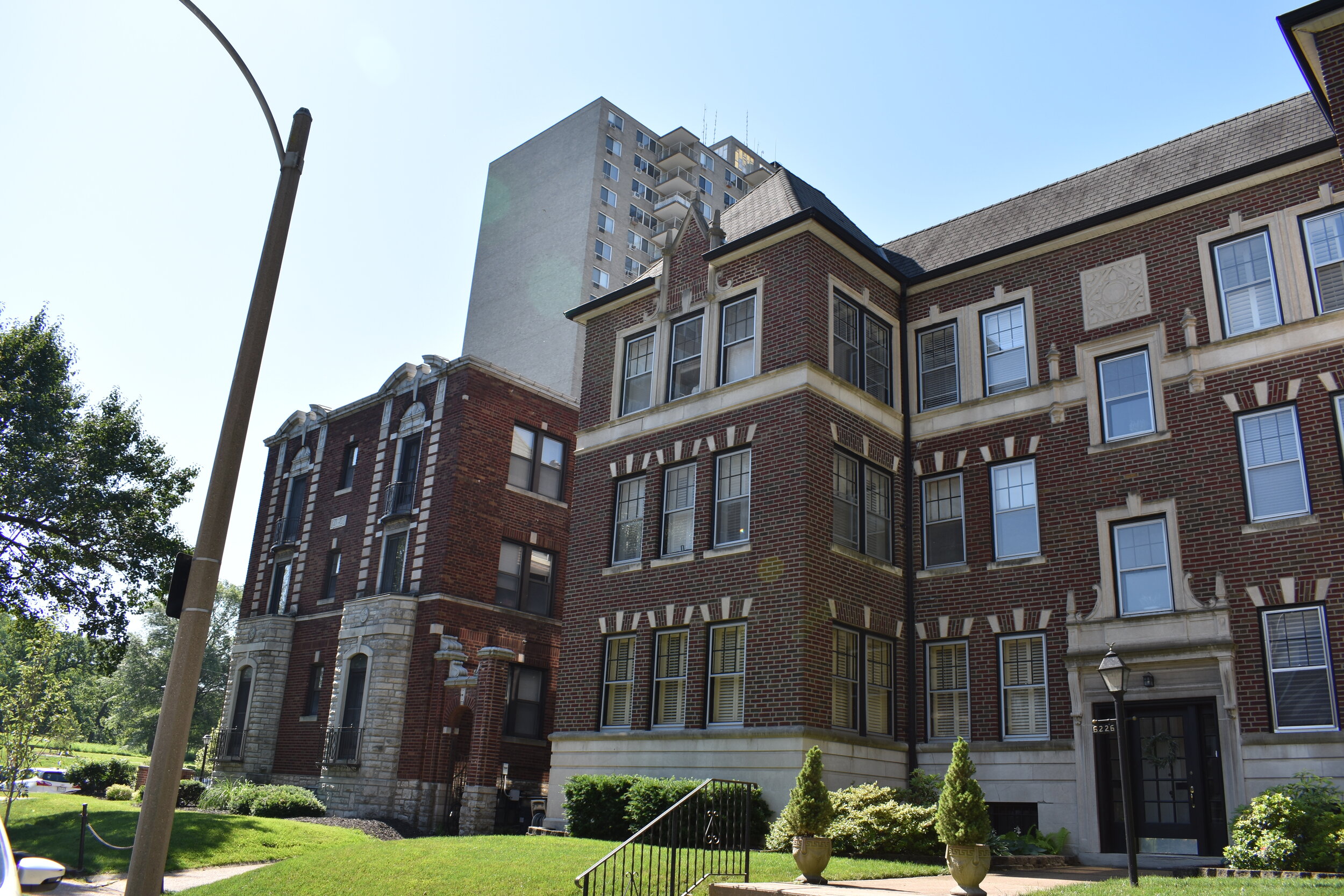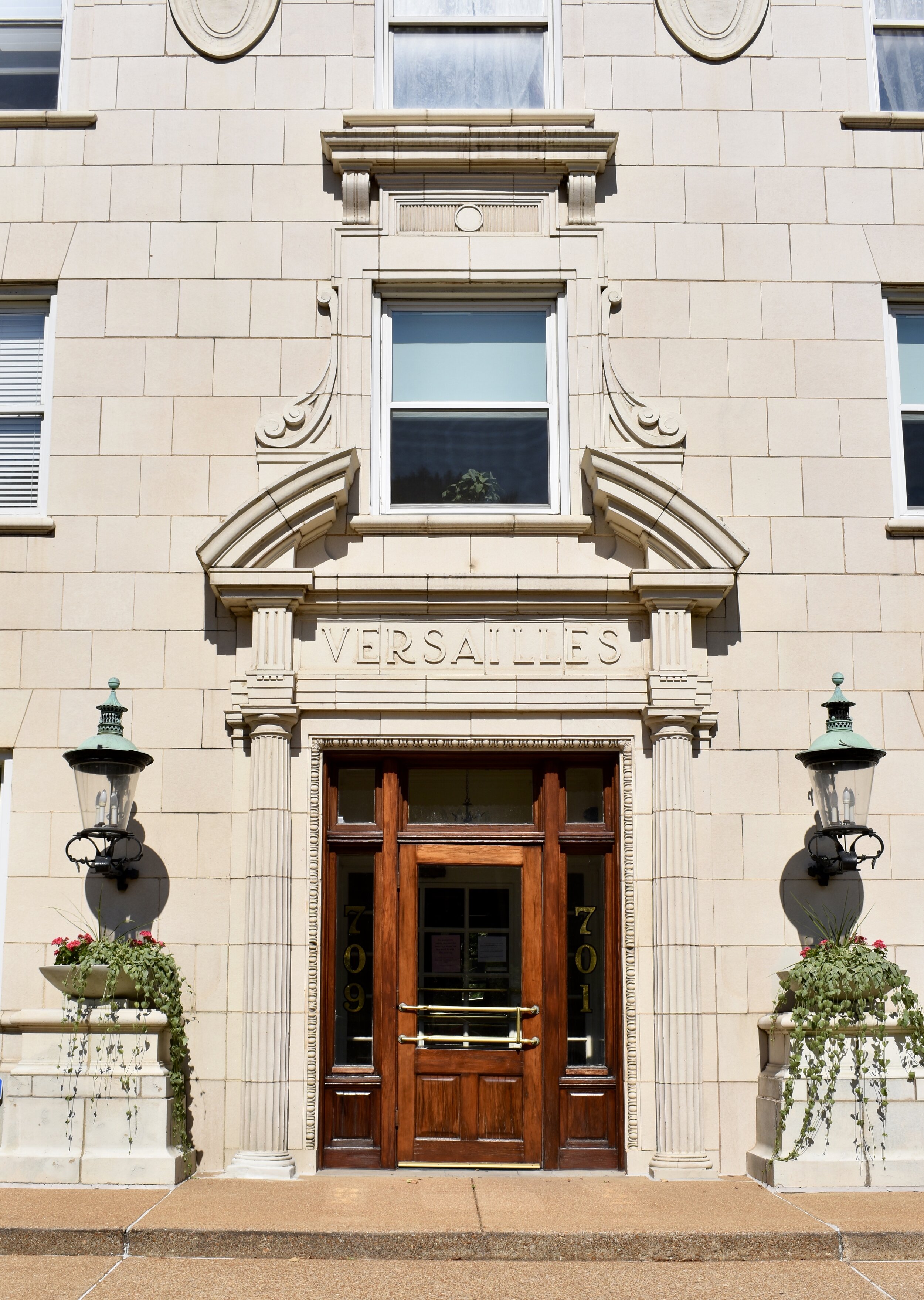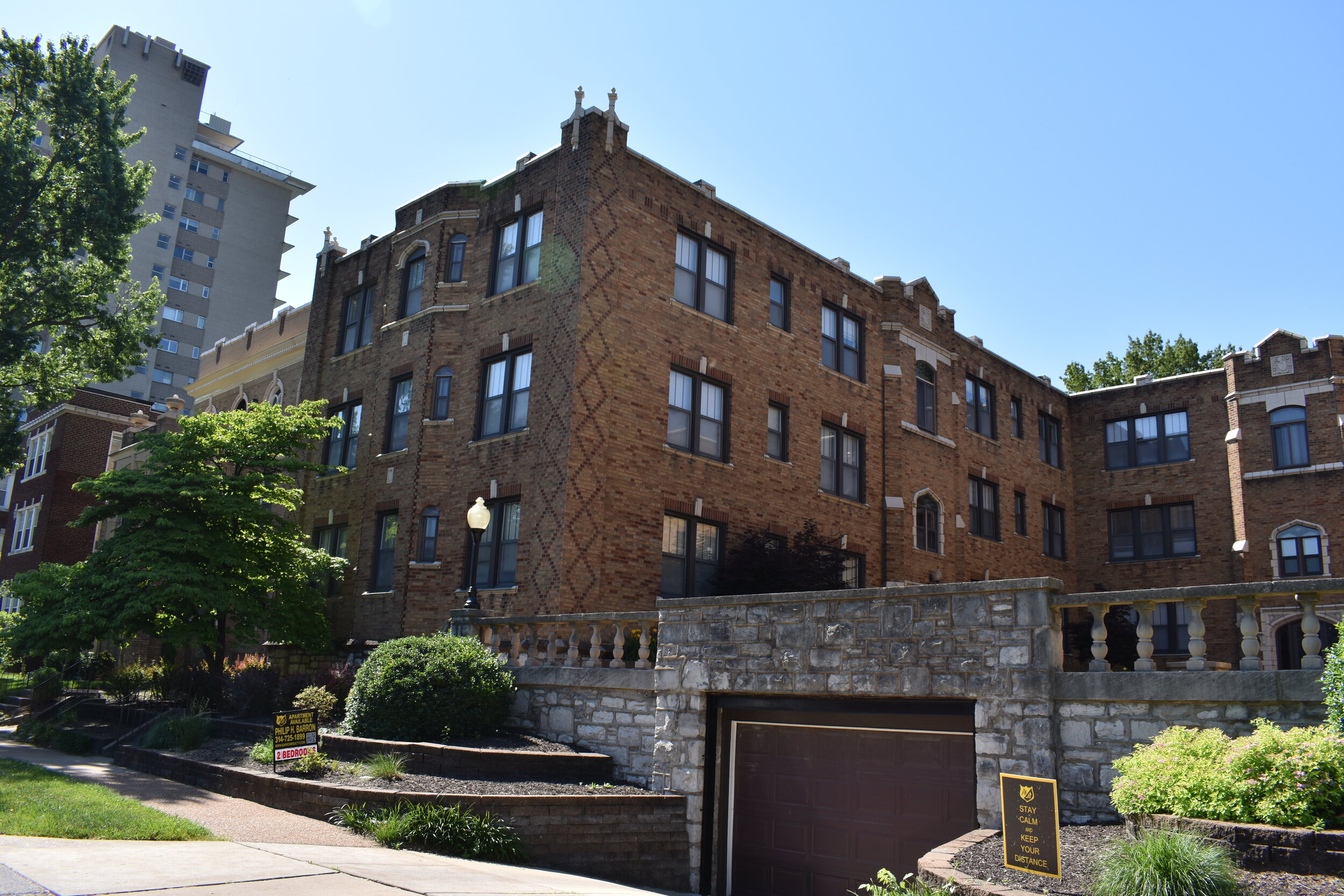Wydown/Skinker is a west-central St. Louis neighborhood bound by Forsyth Boulevard to the north, Clayton Road to the south, the city limits to the west and Skinker Boulevard to the east. These city limit boundaries are somewhat elusive, I have heard that St. Louis extends ~600 feet west of Skinker Blvd. And as I learned in my tour of Ellendale, the city/county streets are paved with different materials and the dumpsters/roll out carts are different in St. Louis vs. the small suburban cities, so the actual border may be traced by keeping a close eye to these indicators.
Wydown Skinker is St. Louis' smallest neighborhood in area. The 2000 census data counted 1,056 residents (down 10% from 1990's count) of whom 3% were black, 90% white 6% Asian and 2% Hispanic/Latino. There were 727 housing units counted, 91% occupied (46%/54% owner/renter split). The 2010 census data indicated a loss of only 2 people, with some slight racial shifts: 86% white, 7% Asian, 3% black and 3% Hispanic/Latino.
From the city website:
“All of Wydown-Skinker was part of the grounds of the 1904 Louisiana Purchase Exposition (the World’s Fair). Within this area were a large Ferris Wheel, part of which was recently excavated in an archaeological exploration, and the complex that housed the Filipino Igorot tribes members brought for “display” as representatives of a new American colony. Washington University located at its current site in 1905, immediately after the closing of the World’s Fair. Several buildings on the campus, including Brookings Hall and Bixby Hall, were used as part of the Fair. Most of the homes and institutions in the neighborhood were built in the 1920s, as the City of Clayton developed. The first homes in Hillcrest were built before World War I, followed by post-World War I construction in Hi-Pointe and Ellenwood. Most of the three-story apartments in DeMun Park were built in the twenties, followed by the first high-rise buildings on Skinker about 1929. The most recent of the latter type date from the early 1960s, such as 665 South Skinker.”
Probably everyone in St. Louis and St. Louis County are familiar with Wydown Skinker as it is the westernmost part of St. Louis that borders beautiful Forest Park along Skinker.
It is also home to the Missouri History Museum Library and Research Center (open to the public):

And certainly you've seen the giant Amoco sign on Clayton and Skinker right next to the Hi-Pointe theater (which isn't in Wydown Skinker, but the Hi-Pointe neighborhood):

Although Amoco is now called British Petroleum (BP), they kept the old Amoco sign that has been here since the 1930’s. Here's some more info from Wikipedia:
Although a few Amoco stations still use their former logo, most have since been converted to the BP livery. In St. Louis, Missouri, near the highest point of the city, the largest Amoco sign in the world, both before and after the company's demise, still stands. It stands at the intersection of Clayton Road, Skinker Boulevard, McCausland Avenue, and Interstate 64/U.S. Highway 40. It is visible up to 2 miles away on the interstate. Most surviving BP stations are kept so BP can continue holding the trademarks for Amoco and Standard.
Another landmark the Cheshire Inn, recently given new exposure in the Oscar nominated film Up In The Air, is partially in Wydown Skinker. The Cheshire Inn restaurant and bar are in the city, the hotel is in the small town of Richmond Heights, MO an inner ring suburb of St. Louis. I believe the movie was actually shot in the restaurant which is in St. Louis, not Richmond Heights.


I'm not the guy that's gonna talk up the 90 or so cities in St. Louis County, I'll leave that to the next guy to talk up all the cool places in the St. Louis suburbs (and there are some here and there). But, man, I've gotta mention some choice snippets from the descriptions of the various "fantasy rooms" off of the Cheshire Inn website:
"the mirrored canopy over the king size bed and fringed lamp shades set this suite apart from your typical hotel room"
"canopy of trees"
"feeling of the high seas"
"heart shaped jacuzzi surrounded by red tinted mirrors"
"surrounded by vines and other greenery to put you in the center of a lush rain forest"
Honey, I hope I'm not showing my hand just too much, but I know exactly where we're going for our next anniversary :)
I am not being a smart aleck, I approve on all levels of the kitsch and otherwise.

^Must....obey....sign....
The suburban small towns of Clayton, MO (population ~16K) and Richmond Heights, MO (populations 8,552) border Wydown Skinker to the west. And, as I mentioned above the St. Louis/Clayton/Richmond Heights dividing line, is not as clear as other neighborhoods but the indicators are there.
In some areas the pavement does tell you when you are in St. Louis or Clayton:


In other areas, Clayton distinctly marks its territory:

On other streets such as Aberdeen, Arundel and Northwood, it's not as clear. I spoke to 4 different residents of WS to get their take on the city/county divide. The first person told me the streets aren't as clear an indicator and that I should look for the city dumpsters/roll carts in the alleys. Great advice.
The second person I spoke to gave me a priceless story to tell. She was doing some yard work in her front yard and I stopped on my scooter to ask her take on the city/county dividing line. I motioned with my hands to indicate I was talking about the streets and properties, and I posed my question: "excuse me ma'am, can you tell me the difference between St. Louis and Clayton?", without pause, she looked me in the eyes and said "attitude". Hell yes! I laughed a jolly laugh, and wanted to give her a hug for preaching to the choir! I knew I didn't phrase my question properly, but her immediate, honest and unfiltered response was great. I pointed to the "CITY" sticker on my scooter and said "I'm a city guy, so you just made my day, and I know exactly what you're talking about". You can pretend all you want that we don't have real divides in this town, but racism and regionalism are our 2 biggest problems on both sides of the argument. I mean, even among the privileged, there is still tension/snobbery and disagreement between county and city dwellers.
Then I asked a homeowner on another street and he pointed me to the concrete marker in the grass which he thought was the city/county marker:

But then he pointed me to his neighbor right down the road who is the president for the Ellenwood neighborhood of Clayton, MO. He was a total gentlemen and said, "follow me, I've got a map." He went to his home and brought out a laminated copy of an original map from April 11, 1923 from the designer of the neighborhood. He pointed out to me that it's not a clear or even straight dividing line. One thing is for sure, you can't discern by the styles of the homes whether you are in Clayton or St. Louis when in the Wydown Skinker neighborhood.
So I've done my best to show you only the properties and places within Wydown Skinker and not Clayton, MO. I'll leave documenting the 91 suburban cities of St. Louis County to the next guy, my task is to talk up St. Louis.
And talking up Wydown Skinker is easy. It's got some of the finest apartment buildings in the city. Not just the multi-families, but the high rises as well. The high rise apartment buildings along Skinker may be the most handsome in all the city, at least rivaling the Central West End and Downtown.
Here are some of the low rise apartments:







Not too bad, eh? But my favorite draw to Wydown Skinker are the high rises that overlook the park:










There are many other interesting sites and institutions within W/S including the Vedanta Society:




The churches:


The homes of Wydown Skinker are certainly exclusive and beautiful.






















Although the photo quality is poor, check out the pitch on this roof toward the right:


Man, the 1920's were good to St. Louis.
Make no mistake, this is an exclusive neighborhood. But, the cool thing about St. Louis is that these large homes built with such pride and craftsmanship are attainable by the hoi polloi. You don't have to be a bazillionaire to own a home like these. There are plenty of homes very similar in style, stature and size in Visitation Park, Academy, West End, etc. that are rehab ready to become showplaces and swanky neighborhoods just like Wydown Skinker.
***In June, 2020 I revisited the neighborhood and the following includes updated commentary and photos.***
Misses On Original Tour
There is no official city park in Wydown Skinker, but of course Forest Park is right across Skinker.
Noticeable Changes
The Amoco sign was recently repainted with their newer logo now that they have revived the brand.
The “fantasy rooms” at the Cheshire Inn are no more.
The home sale prices have spiked in recent years. But, there is not much else that has changed in the last ten years. The average home sale in 2019 was just under $700,000 and in 2018 it was $418,000. Per City-Data.com, the average rent in 2016 $1,104, average home value $550,000 and 100% of the K-12 children attend private schools.
The neighborhood has nice diversity though, 14% of residents were born outside the U.S. and only 37% were born in Missouri, meaning there are lots of people from other places settling down here.
What Are The Future Needs?
Traffic calming on Skinker and Clayton Road, better and more frequent pedestrian crossings into the park…that’s all I can come up with. The neighborhood is built out and pretty much at full capacity.
Additional St. Louis City Talk Reading
Just a few more photos, not really misses, just some updates to keep it interesting.
I will leave you with one of my favorites:








